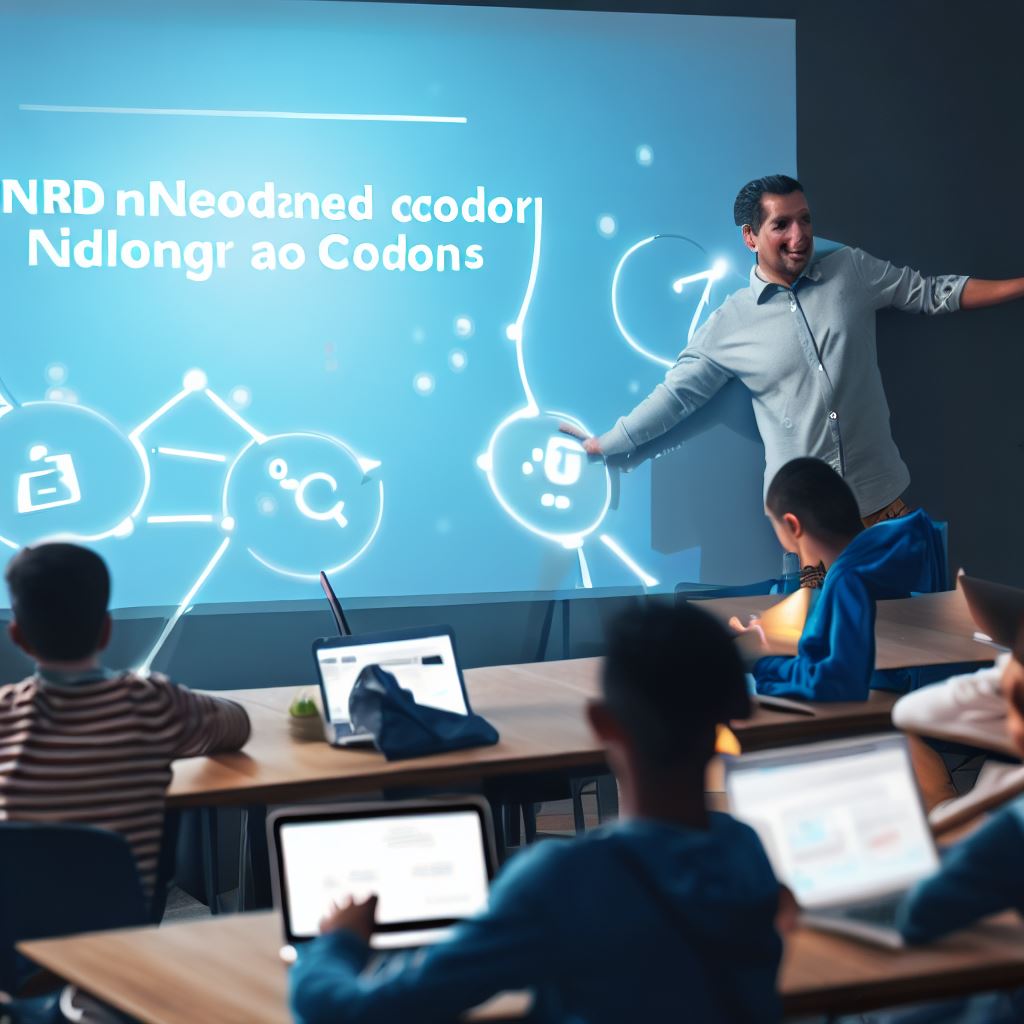Introduction
Interactive presentations are a cornerstone of effective teaching, capturing learners’ attention and enhancing comprehension.
In today’s digital age, Nearpod stands out as a favored tool for crafting engaging and interactive presentations.
This blog post aims to explore the art of integrating Nearpod Codes effectively into presentations, maximizing learner engagement and facilitating a deeper understanding of the material.
Dive into the world of interactive teaching and discover how Nearpod can transform your presentations into dynamic, immersive learning experiences.
Read: Adding HTML Audio: A Guide to Web-Based Playback
Understanding Nearpod Codes
- Nearpod Codes are interactive presentation tools that allow audience participation.
- These codes are unique and can be accessed by participants to join the presentation.
- When participants enter the code, they can view the presentation on their own devices.
- Participants can interact with the presentation, answer quizzes, submit responses, and ask questions.
- Using Nearpod Codes, presenters can gauge audience understanding and engagement in real-time.
- This interactive feature enhances the overall learning experience in presentations.
Benefits of Using Nearpod Codes
- Nearpod Codes enable presenters to create a more engaging and interactive environment.
- Participants feel more involved in the presentation, leading to increased attention and focus.
- Real-time feedback allows presenters to adapt their content based on audience understanding.
- Quizzes and polls through Nearpod Codes encourage active participation and critical thinking.
- Presenters can easily monitor and assess individual participant responses for evaluation purposes.
- The ability to ask and answer questions through Nearpod Codes promotes a collaborative learning atmosphere.
Interactive Activities with Nearpod Codes
Nearpod Codes elevate presentations with dynamic and inclusive features, nurturing active participation and boosting learning outcomes:
- Virtual Tours: Participants explore different locations through Nearpod Codes, enhancing understanding.
- Quizzes: Interactive quizzes test participant knowledge instantly, fostering critical thinking.
- Polls and Surveys: Real-time feedback collected via Nearpod Codes aids comprehension assessment.
- Drawing and Annotation: Participants engage by drawing and annotating using Nearpod Codes.
- Collaborative Boards: Codes facilitate group brainstorming and idea sharing, promoting teamwork.
- Mind Mapping: Presenters engage participants in mind-mapping activities through Nearpod Codes.
This integration enhances presentations, promoting active participation and deeper understanding.
Participants engage with content actively, improving knowledge retention.
For instance, a history presentation can use Nearpod Codes for virtual tours of historical sites, deepening immersion.
Similarly, in science presentations, Nearpod Codes enable quizzes and polls for instant comprehension evaluation and clarification.
Codes foster collaborative learning with group activities like collaborative boards and mind mapping, encouraging teamwork and creativity.
Drawing, annotating, and brainstorming together enrich the shared learning experience.
Leverage Nearpod Codes to revolutionize presentations, increasing participation, providing real-time feedback, and enhancing collaboration.
With interactive activities like virtual tours, quizzes, polls, drawing, and collaboration, create an immersive and inclusive learning environment.
Unlock the power of Nearpod Codes to transform presentations into interactive, impactful experiences.
Tech Consulting Tailored to Your Coding Journey
Get expert guidance in coding with a personalized consultation. Receive unique, actionable insights delivered in 1-3 business days.
Get StartedRead: Making the Most of Nearpod: Code Management Best Practices

Find Out More: Creating a User Authentication System with CodeIgniter
Tips for Integrating Nearpod Codes Effectively
Preparing the Presentation
- Understand the learning objectives and select appropriate interactive activities.
- Organize the content of the presentation to flow seamlessly with the Nearpod Codes.
- Ensure all necessary materials, such as images or videos, are ready for integration.
Engaging the Audience
- Use attention-grabbing titles and descriptions for each Nearpod Code activity.
- Incorporate polls, quizzes, or open-ended questions to encourage active participation.
- Encourage collaboration and discussion through interactive features like collaborative boards or chat functions.
Timing and Pace
- Determine the appropriate timing for each Nearpod Code activity to maintain engagement.
- Pace the presentation thoughtfully, allowing enough time for students to interact and respond.
- Use the live results feature of Nearpod to determine when to move forward in the presentation.
Assessing Understanding
- Utilize the data and reports generated by Nearpod to assess students’ comprehension during the presentation.
- Tailor the presentation based on the data to address any misconceptions or areas of weakness.
- Provide opportunities for students to ask questions or seek clarification during or after the presentation.
Read: Understanding CodingBat’s Logic Puzzles: A Tutorial
Best Practices and Examples
In order to create interactive and engaging Nearpod presentations, it is important to follow some best practices.
These practices have been proven effective in enhancing student engagement and participation:
- Design slides with visually appealing images and colors to capture students’ attention.
- Include multimedia elements like videos, audios, and interactive quizzes to make the presentation more interactive.
- Break up content into smaller sections or slides to avoid overwhelming students with information.
- Use interactive features like polls, open-ended questions, and quizzes to encourage active participation.
- Provide opportunities for collaborative learning by incorporating interactive activities that require group work.
- Consider the pacing of your presentation and allow time for students to absorb and reflect on the information.
- Ensure that Nearpod Codes are easily accessible and visible to all students throughout the presentation.
- Personalize the presentation by adding your voice to the content, providing explanations and additional insights.
- Regularly assess students’ understanding by integrating formative assessments throughout the presentation.
- Offer feedback and reinforcement to students during the presentation to keep them engaged and motivated.
Examples of successful usage of Nearpod Codes in different subjects or grade levels
These best practices can be applied to various subjects and grade levels.
Here are some examples of successful usage of Nearpod Codes:
- In a science class, a teacher used Nearpod Codes to present a virtual dissection of a frog, allowing students to explore the anatomy interactively.
- In a history lesson, a teacher used Nearpod to create a virtual tour of ancient civilizations, guiding students through different architectural marvels and artifacts.
- In an English literature class, a teacher used Nearpod Codes to share interactive quizzes and discussions on various literary works, fostering critical thinking.
- In a math class, a teacher used Nearpod Codes to present real-life problem scenarios, encouraging students to apply their mathematical skills in practical situations.
- In a foreign language class, a teacher used Nearpod Codes to facilitate interactive language exercises, allowing students to practice speaking and listening skills.
To gain further insights and tips from experienced educators, here are some testimonials on effectively integrating Nearpod Codes into presentations:
“I have noticed a significant improvement in student engagement since I started using Nearpod Codes.
The interactive features keep students involved and motivated to participate actively in the lessons.” – Mary, High School Teacher
“Nearpod Codes have transformed my teaching.
They allow me to bring the content to life and provide personalized learning experiences for each student. It’s a game-changer!” – John, Middle School Teacher
“The instant feedback provided by Nearpod Codes helps me understand how well my students are grasping the concepts.
It allows me to intervene and provide support where needed.” – Sarah, Elementary School Teacher
Build Your Vision, Perfectly Tailored
Get a custom-built website or application that matches your vision and needs. Stand out from the crowd with a solution designed just for you—professional, scalable, and seamless.
Get StartedBy following these best practices, incorporating interactive elements, and learning from experienced educators, you can effectively integrate Nearpod Codes into your presentations, creating an interactive and engaging learning experience for your students.
Read: From Blocks to Text: Transitioning Kids to Real Code
Explore Further: Why Coding and Programming Aren’t Interchangeable Terms
Gain More Insights: Is PHP Dead? The Status of Web Development in 2024
Conclusion
To conclude, integrating Nearpod Codes effectively in interactive presentations offers numerous benefits.
It enhances student engagement, promotes active learning, and increases overall comprehension.
Educators are encouraged to explore and experiment with Nearpod to maximize student participation and improve learning outcomes.
In this digital age, it is essential to keep up with innovative teaching tools such as Nearpod.
By incorporating this technology into their instructional strategies, educators can create dynamic and interactive learning experiences for their students.
By making use of Nearpod’s features, educators can ensure that their students remain focused and attentive during presentations.
Furthermore, by using Nearpod Codes effectively, educators can foster collaboration and interaction among students, allowing them to share their ideas and thoughts in real-time.
This not only promotes critical thinking and problem-solving skills but also encourages a sense of community and active participation.
Educators are encouraged to embrace the use of Nearpod in their upcoming presentations.
By trying out this innovative tool, they can enhance student engagement, improve comprehension, and ultimately create a more effective learning environment.
Optimize Your Profile, Get Noticed
Make your resume and LinkedIn stand out to employers with a profile that highlights your technical skills and project experience. Elevate your career with a polished and professional presence.
Get NoticedAdditionally, educators can continue to explore other teaching tools that can further support their instructional goals and enhance their students’ learning experiences.




